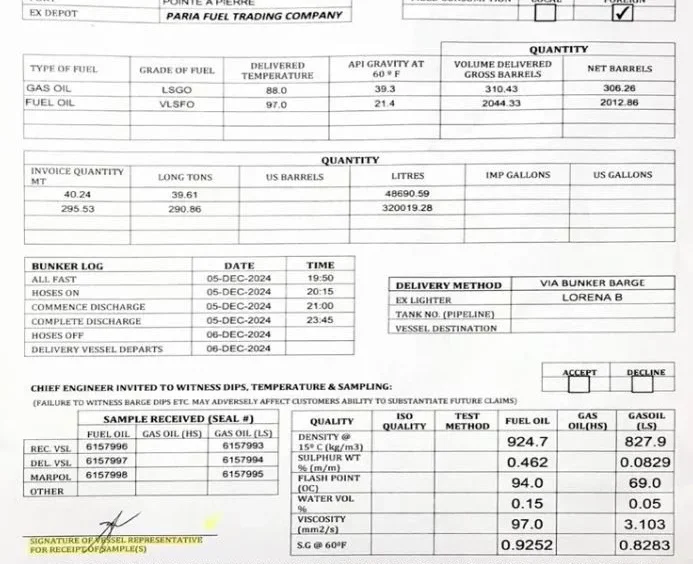When you are sailing onboard a ship, especially during your first few sailings, you will hear this term often during bunkering: BDN or Bunker Delivery Note. It may look like just another paper, but it is actually a very important legal document and plays a big role in fuel quality, pollution control, and even during Port State Control inspections.
So let’s break it down in simple and practical terms.
What is BDN?
BDN stands for Bunker Delivery Note. It is a document provided by the fuel supplier during bunkering (fuel transfer operation). It contains full details of the type, quantity, and quality of the fuel that has been supplied to the ship.
This document is required by MARPOL Annex VI and must be kept onboard for at least 3 years.
What Details Are Mentioned on a BDN?
A standard BDN includes:
Name and IMO number of the ship
Port and date of bunkering
Name of the bunker barge or truck
Quantity supplied (in metric tonnes)
Fuel grade and type (like VLSFO, HSFO, MGO)
Sulphur content (very important due to IMO 2020 rules)
Density at 15°C
Viscosity
Flash point
Supplier’s declaration confirming compliance with MARPOL Annex VI
Signature of both parties, Chief Engineer or Master, and supplier representative
As a Cadet or Junior Officer, What Should You Know?
During bunkering, even if you are not signing the BDN, your eyes and mind must be alert. Here are a few key points:
- Cross-Check Before Signing
Chief Engineer will check the actual bunker received through tank soundings. These figures should match the quantity in the BDN. If there is a big difference, it must be reported immediately.
- Look at the Sulphur Content
Make sure it matches the fuel type. For example, inside Emission Control Areas (ECAs), sulphur must be not more than 0.10 percent. Outside ECAs, maximum allowed is 0.50 percent.
- Fuel Grade Must Match What Was Ordered
Sometimes suppliers make mistakes. Never just assume. Always verify.
- Check for Tampering
If any correction is made on the BDN, it must be signed and stamped properly. No overwriting without proper authentication.
What Happens If BDN is Wrong?
A wrong or fake BDN can cause:
Engine damage due to wrong grade
Heavy fines during PSC
Detention of the vessel
Legal trouble for the company
So, it must be taken seriously.
What is the Deck Officer’s Role in Bunkering?
Usually, the Chief Engineer and 2nd Engineer handle the technical side. But deck officers also have duties:
Safe mooring of the bunker barge
Monitoring communication with the engine room
Oil pollution prevention checks
Oil spill equipment readiness
Tank soundings if required
Witnessing sampling if asked
Keeping general watch over the operation
Where Is the BDN Kept?
The Chief Engineer keeps the original in the engine room file, usually under the fuel records section. A copy may also be kept on the bridge, especially during PSC or vetting inspections.
Final Thoughts
BDN is not just paperwork. It is proof of what goes into your ship’s engine. It protects the ship legally, technically, and environmentally. As a cadet or junior officer, you may not be signing it, but you should understand it fully and learn how to check the important entries.
Ask questions during bunkering. Learn from your Chief Engineer and Duty Officer. Fuel is the lifeblood of the ship and BDN is the blood report.
Pro Tip:
If you’re in the bridge team, note the time of bunker start and stop, barge name, and total quantity in the deck logbook. Everything must match what’s written on the


